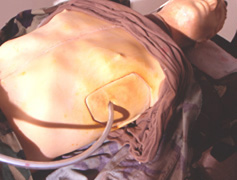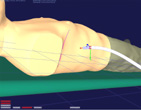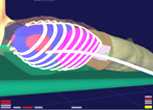 |

 |
|
 |
VIRGIL™ was developed by a team of researchers and scientists from The Simulation Group at CIMIT (Center for Integration of Medicine & Innovative Technology). CIMIT’s mission is to apply advanced technology to medicine in effective ways. As part of this effort, The Simulation Group works closely with the US Army Medical Research & Materiel Command and the Special Forces Medical Command to create new methods to train medics for combat casualty care. The team’s research extends the limits of human computer interactions permitting realistic medical scenarios for safe, risk free familiarization and competency testing without the need for animal training.
The VIRGIL™ system combines the use of a realistic mannequin with a PC-based graphical interface that tracks the internal position of chest darts and chest tubes during training exercises. VIRGIL™ provides realistic force feedback during the skin incision, dissection through intercostal muscle and pleura, and subsequent placement of a 36Fr chest tube.
As the educational scenarios become progressively more difficult, the system tracks the trainee’s progress and detects patterns of error. The system is used in a trainee/instructor configuration, with about 10 minutes required per trainee. A web-based educational tutorial is also available for refresher training.
VIRGIL™ the first practical demonstration of a long-term research program, directly addresses the expressed needs of the Special Forces Medics to learn and practice safe treatment of combat chest trauma. The simulator combines sophisticated 3-D anatomic models generated from CT Scans of actual human anatomy with a mannequin built utilizing the same measurements as the computer models. Since the internal organs are proper in size, location, and density, mistakes that would happen in the real world will also happen realistically in the simulator. This anatomic realism contributes to “transfer of learning” from the simulated world to real world trauma scenarios. Through a collaboration between the Uniformed Services University of the Health Sciences (USUHS) in Bethesda, MD and Boston Med- Flight, the Simulation Group participated in a series of controlled studies designed to validate the VIRGIL™ Chest Trauma Training System in a classroom environment. Participants responded enthusiastically to VIRGIL™ citing better visualization and increased understanding of the procedure. Preliminary results indicate the system met or exceeded existing lab training methods. Validation tests will continue into 2003.

Copyright
© CIMIT 2002. All rights reserved


